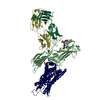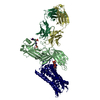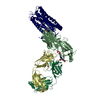+ データを開く
データを開く
- 基本情報
基本情報
| 登録情報 | データベース: PDB / ID: 9m0d | ||||||
|---|---|---|---|---|---|---|---|
| タイトル | Cryo-EM structure of neurotensin receptor 1 in complex with beta-arrestin 1 | ||||||
 要素 要素 |
| ||||||
 キーワード キーワード | MEMBRANE PROTEIN / GPCR / Neurotensin receptore 1 / Complex / beta-arrestin 1 / Phosphorylation | ||||||
| 機能・相同性 |  機能・相同性情報 機能・相同性情報G protein-coupled neurotensin receptor activity / inositol phosphate catabolic process / symmetric synapse / angiotensin receptor binding / D-aspartate import across plasma membrane / positive regulation of gamma-aminobutyric acid secretion / TGFBR3 regulates TGF-beta signaling / Activation of SMO / regulation of membrane depolarization / positive regulation of arachidonate secretion ...G protein-coupled neurotensin receptor activity / inositol phosphate catabolic process / symmetric synapse / angiotensin receptor binding / D-aspartate import across plasma membrane / positive regulation of gamma-aminobutyric acid secretion / TGFBR3 regulates TGF-beta signaling / Activation of SMO / regulation of membrane depolarization / positive regulation of arachidonate secretion / negative regulation of interleukin-8 production / L-glutamate import across plasma membrane / regulation of respiratory gaseous exchange / positive regulation of inhibitory postsynaptic potential / G protein-coupled receptor internalization / arrestin family protein binding / negative regulation of systemic arterial blood pressure / negative regulation of release of sequestered calcium ion into cytosol / positive regulation of glutamate secretion / Lysosome Vesicle Biogenesis / negative regulation of NF-kappaB transcription factor activity / temperature homeostasis / positive regulation of inositol phosphate biosynthetic process / positive regulation of cardiac muscle hypertrophy / stress fiber assembly / Golgi Associated Vesicle Biogenesis / response to lipid / positive regulation of Rho protein signal transduction / pseudopodium / detection of temperature stimulus involved in sensory perception of pain / negative regulation of interleukin-6 production / positive regulation of receptor internalization / negative regulation of Notch signaling pathway / enzyme inhibitor activity / neuropeptide signaling pathway / insulin-like growth factor receptor binding / clathrin-coated pit / negative regulation of protein ubiquitination / GTPase activator activity / cytoplasmic vesicle membrane / Activated NOTCH1 Transmits Signal to the Nucleus / Peptide ligand-binding receptors / positive regulation of release of sequestered calcium ion into cytosol / dendritic shaft / adult locomotory behavior / learning / electron transport chain / G protein-coupled receptor binding / Signaling by high-kinase activity BRAF mutants / G protein-coupled receptor activity / MAP2K and MAPK activation / cytoplasmic side of plasma membrane / positive regulation of protein phosphorylation / terminal bouton / Signaling by RAF1 mutants / Signaling by moderate kinase activity BRAF mutants / Paradoxical activation of RAF signaling by kinase inactive BRAF / Signaling downstream of RAS mutants / endocytic vesicle membrane / Signaling by BRAF and RAF1 fusions / Cargo recognition for clathrin-mediated endocytosis / protein transport / Thrombin signalling through proteinase activated receptors (PARs) / Clathrin-mediated endocytosis / cytoplasmic vesicle / ubiquitin-dependent protein catabolic process / perikaryon / G alpha (s) signalling events / G alpha (q) signalling events / molecular adaptor activity / chemical synaptic transmission / dendritic spine / proteasome-mediated ubiquitin-dependent protein catabolic process / periplasmic space / transcription coactivator activity / electron transfer activity / positive regulation of ERK1 and ERK2 cascade / Ub-specific processing proteases / protein ubiquitination / nuclear body / positive regulation of apoptotic process / G protein-coupled receptor signaling pathway / iron ion binding / membrane raft / Golgi membrane / lysosomal membrane / heme binding / ubiquitin protein ligase binding / positive regulation of gene expression / regulation of transcription by RNA polymerase II / negative regulation of apoptotic process / chromatin / protein-containing complex binding / cell surface / endoplasmic reticulum / Golgi apparatus / signal transduction / positive regulation of transcription by RNA polymerase II / nucleoplasm / identical protein binding 類似検索 - 分子機能 | ||||||
| 生物種 |   Homo sapiens (ヒト) Homo sapiens (ヒト) | ||||||
| 手法 | 電子顕微鏡法 / 単粒子再構成法 / クライオ電子顕微鏡法 / 解像度: 3.41 Å | ||||||
 データ登録者 データ登録者 | Sun, D.M. / Li, X. / Yuan, Q.N. / Tian, C.L. | ||||||
| 資金援助 | 1件
| ||||||
 引用 引用 |  ジャーナル: Cell Res / 年: 2025 ジャーナル: Cell Res / 年: 2025タイトル: Molecular mechanism of the arrestin-biased agonism of neurotensin receptor 1 by an intracellular allosteric modulator. 著者: Demeng Sun / Xiang Li / Qingning Yuan / Yuanxia Wang / Pan Shi / Huanhuan Zhang / Tao Wang / Wenjing Sun / Shenglong Ling / Yuanchun Liu / Jinglin Lai / Wenqin Xie / Wanchao Yin / Lei Liu / H ...著者: Demeng Sun / Xiang Li / Qingning Yuan / Yuanxia Wang / Pan Shi / Huanhuan Zhang / Tao Wang / Wenjing Sun / Shenglong Ling / Yuanchun Liu / Jinglin Lai / Wenqin Xie / Wanchao Yin / Lei Liu / H Eric Xu / Changlin Tian /  要旨: Biased allosteric modulators (BAMs) of G protein-coupled receptors (GPCRs) have been at the forefront of drug discovery owing to their potential to selectively stimulate therapeutically relevant ...Biased allosteric modulators (BAMs) of G protein-coupled receptors (GPCRs) have been at the forefront of drug discovery owing to their potential to selectively stimulate therapeutically relevant signaling and avoid on-target side effects. Although structures of GPCRs in complex with G protein or GRK in a BAM-bound state have recently been resolved, revealing that BAM can induce biased signaling by directly modulating interactions between GPCRs and these two transducers, no BAM-bound GPCR-arrestin complex structure has yet been determined, limiting our understanding of the full pharmacological profile of BAMs. Herein, we developed a chemical protein synthesis strategy to generate neurotensin receptor 1 (NTSR1) with defined hexa-phosphorylation at its C-terminus and resolved high-resolution cryo-EM structures (2.65-2.88 Å) of NTSR1 in complex with both β-arrestin1 and the BAM SBI-553. These structures revealed a unique "loop engagement" configuration of β-arrestin1 coupling to NTSR1 in the presence of SBI-553, markedly different from the typical "core engagement" configuration observed in the absence of BAMs. This configuration is characterized by the engagement of the intracellular loop 3 of NTSR1 with a cavity in the central crest of β-arrestin1, representing a previously unobserved, arrestin-selective conformation of GPCR. Our findings fill the critical knowledge gap regarding the regulation of GPCR-arrestin interactions and biased signaling by BAMs, which would advance the development of safer and more efficacious GPCR-targeted therapeutics. | ||||||
| 履歴 |
|
- 構造の表示
構造の表示
| 構造ビューア | 分子:  Molmil Molmil Jmol/JSmol Jmol/JSmol |
|---|
- ダウンロードとリンク
ダウンロードとリンク
- ダウンロード
ダウンロード
| PDBx/mmCIF形式 |  9m0d.cif.gz 9m0d.cif.gz | 199.5 KB | 表示 |  PDBx/mmCIF形式 PDBx/mmCIF形式 |
|---|---|---|---|---|
| PDB形式 |  pdb9m0d.ent.gz pdb9m0d.ent.gz | 表示 |  PDB形式 PDB形式 | |
| PDBx/mmJSON形式 |  9m0d.json.gz 9m0d.json.gz | ツリー表示 |  PDBx/mmJSON形式 PDBx/mmJSON形式 | |
| その他 |  その他のダウンロード その他のダウンロード |
-検証レポート
| 文書・要旨 |  9m0d_validation.pdf.gz 9m0d_validation.pdf.gz | 1.1 MB | 表示 |  wwPDB検証レポート wwPDB検証レポート |
|---|---|---|---|---|
| 文書・詳細版 |  9m0d_full_validation.pdf.gz 9m0d_full_validation.pdf.gz | 1.1 MB | 表示 | |
| XML形式データ |  9m0d_validation.xml.gz 9m0d_validation.xml.gz | 38.3 KB | 表示 | |
| CIF形式データ |  9m0d_validation.cif.gz 9m0d_validation.cif.gz | 58 KB | 表示 | |
| アーカイブディレクトリ |  https://data.pdbj.org/pub/pdb/validation_reports/m0/9m0d https://data.pdbj.org/pub/pdb/validation_reports/m0/9m0d ftp://data.pdbj.org/pub/pdb/validation_reports/m0/9m0d ftp://data.pdbj.org/pub/pdb/validation_reports/m0/9m0d | HTTPS FTP |
-関連構造データ
- リンク
リンク
- 集合体
集合体
| 登録構造単位 | 
|
|---|---|
| 1 |
|
- 要素
要素
| #1: タンパク質 | 分子量: 62097.848 Da / 分子数: 1 / 由来タイプ: 組換発現 由来: (組換発現)   Homo sapiens (ヒト) Homo sapiens (ヒト)遺伝子: cybC, NTSR1, NTRR 発現宿主: Mammalian expression vector Flag-MCS-pcDNA3.1 (その他) 参照: UniProt: P0ABE7, UniProt: P30989 |
|---|---|
| #2: タンパク質 | 分子量: 45224.598 Da / 分子数: 1 / 由来タイプ: 組換発現 / 由来: (組換発現)  Homo sapiens (ヒト) / 遺伝子: ARRB1, ARR1 Homo sapiens (ヒト) / 遺伝子: ARRB1, ARR1発現宿主:  参照: UniProt: P49407 |
| #3: 抗体 | 分子量: 27727.010 Da / 分子数: 1 / 由来タイプ: 組換発現 / 由来: (組換発現)  Homo sapiens (ヒト) Homo sapiens (ヒト)発現宿主:  |
| #4: 抗体 | 分子量: 25422.467 Da / 分子数: 1 / 由来タイプ: 組換発現 / 由来: (組換発現)  Homo sapiens (ヒト) Homo sapiens (ヒト)発現宿主:  |
| 研究の焦点であるリガンドがあるか | Y |
| Has protein modification | Y |
-実験情報
-実験
| 実験 | 手法: 電子顕微鏡法 |
|---|---|
| EM実験 | 試料の集合状態: PARTICLE / 3次元再構成法: 単粒子再構成法 |
- 試料調製
試料調製
| 構成要素 | 名称: Ternary complex of neurotensin receptor 1 with beta-arrestin 1 and Fab30 タイプ: COMPLEX / Entity ID: all / 由来: RECOMBINANT |
|---|---|
| 分子量 | 実験値: NO |
| 由来(天然) | 生物種:  Homo sapiens (ヒト) Homo sapiens (ヒト) |
| 由来(組換発現) | 生物種: Mammalian expression vector Flag-MCS-pcDNA3.1 (その他) |
| 緩衝液 | pH: 7.4 |
| 試料 | 包埋: NO / シャドウイング: NO / 染色: NO / 凍結: YES |
| 急速凍結 | 凍結剤: ETHANE |
- 電子顕微鏡撮影
電子顕微鏡撮影
| 実験機器 |  モデル: Talos Arctica / 画像提供: FEI Company |
|---|---|
| 顕微鏡 | モデル: FEI TECNAI ARCTICA |
| 電子銃 | 電子線源:  FIELD EMISSION GUN / 加速電圧: 300 kV / 照射モード: FLOOD BEAM FIELD EMISSION GUN / 加速電圧: 300 kV / 照射モード: FLOOD BEAM |
| 電子レンズ | モード: BRIGHT FIELD / 最大 デフォーカス(公称値): 2000 nm / 最小 デフォーカス(公称値): 800 nm |
| 撮影 | 電子線照射量: 50 e/Å2 フィルム・検出器のモデル: GATAN K3 BIOQUANTUM (6k x 4k) |
- 解析
解析
| EMソフトウェア | 名称: PHENIX / バージョン: 1.20.1_4487 / カテゴリ: モデル精密化 | ||||||||||||||||||||||||
|---|---|---|---|---|---|---|---|---|---|---|---|---|---|---|---|---|---|---|---|---|---|---|---|---|---|
| CTF補正 | タイプ: PHASE FLIPPING AND AMPLITUDE CORRECTION | ||||||||||||||||||||||||
| 3次元再構成 | 解像度: 3.41 Å / 解像度の算出法: FSC 0.143 CUT-OFF / 粒子像の数: 6359592 / 対称性のタイプ: POINT | ||||||||||||||||||||||||
| 精密化 | 最高解像度: 3.41 Å 立体化学のターゲット値: REAL-SPACE (WEIGHTED MAP SUM AT ATOM CENTERS) | ||||||||||||||||||||||||
| 拘束条件 |
|
 ムービー
ムービー コントローラー
コントローラー










 PDBj
PDBj






















